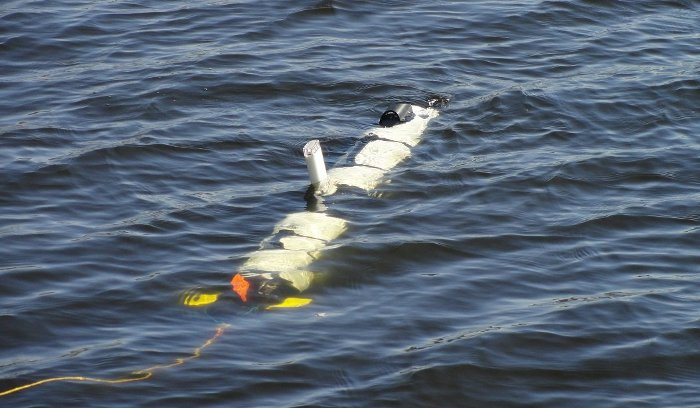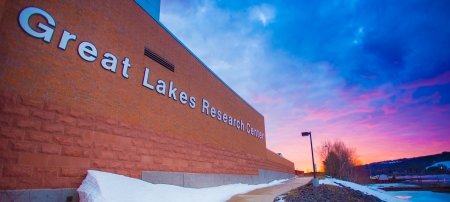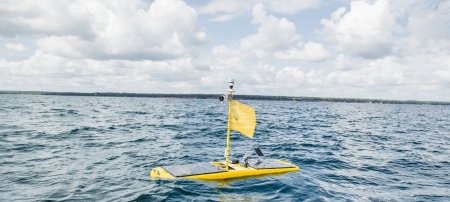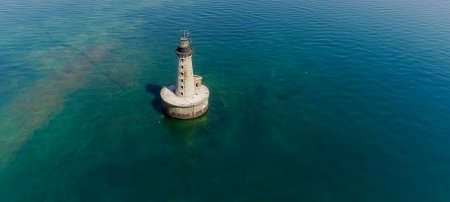Great Lakes Research Center: One Year Old and Growing

This time last year, the finishing touches were just being put on Michigan Technological University’s Great Lakes Research Center (GLRC). Researchers were starting to move in, and plans were being made for a mid-summer building dedication.
What a difference a year makes. Now celebrating its first anniversary, the GLRC is fast becoming the go-to source for data about the Great Lakes and the home of pioneering investigations into solutions to the challenges facing them.
“This is a unique, amazing place,” says Guy Meadows, director of the GLRC. Meadows came to Michigan Tech from the University of Michigan to lead the Great Lakes research efforts here. “Scientists from all across the basin have their eyes on us. The future of Great Lakes research is based right here.”
Two new senior scientists from the National Oceanic and Atmospheric Administration (NOAA), Great Lakes Environmental Research Laboratory in Ann Arbor have joined the 23 research faculty already associated with the GLRC. Gary Fahnenstiel and David Schwab are helping the GLRC develop its Great Lakes research programs.
Fahnenstiel is the former head of the Lake Michigan Field Station for NOAA. He is an expert in Great Lakes primary productivity (the rate at which energy is converted to organic material) and phytoplankton dynamics—the interaction of microscopic aquatic plants with their environment. He also is an adjunct professor of biological sciences at Michigan Tech.
Schwab was the creator of the Great Lakes Coastal Forecasting System, the tool that the National Weather Service uses throughout the Great Lakes basin to forecast wind, waves, circulation, temperature and water levels. He is an expert in numerical hydrodynamics, the application of the principles of fluid dynamics to develop mathematic models of the movement of fluids.
David Millie has also joined the GLRC research team from Florida. He is an expert in phycology—the study of algae, including harmful algal blooms —as well as coastal marine and estuary/wetland biology.
Another new faculty member will join the GLRC at the end of summer. Dr. Pengfei Xue is coming from MIT to Michigan Tech as part of the university’s Strategic Faculty Hiring Initiative in water systems. He will work with Schwab to develop the next generation of numerical predictive models for the Great Lakes, using Michigan Tech’s new supercomputer housed in the GLRC.
Just as it was always intended to be, the GLRC is more than a building. It is a dynamic network of biologists, geologists, engineers, chemists, remote sensing specialists and computer scientists, working together and separately, collaborating and consulting, stitching together a multidisciplinary picture of the Great Lakes, their tributaries and the lands that line their shores. Each contributes special expertise and insight to create a whole that is greater than the sum of its parts,
“The interaction among researchers is unusual,” says Meadows. “People from the Michigan Tech Research Institute down in Ann Arbor, the US Army Corps of Engineers Environmental Lab in Vicksburg, Miss., the University of Michigan, and faculty from all over campus are pooling their expertise to solve the problems of the Great Lakes.”
Corporations are becoming players too. A corporate partnership with Mercury Marine has turned the GLRC into a Mercury test facility and produced a new motor for the center’s smaller research boat. Another partnership with Kohler resulted in a diesel generator for the center’s larger research vessel.
Under a new research contract with Canadian-based Enbridge—one of North America’s largest transporters of energy—the GLRC is helping develop new techniques for pipeline inspection. The goal: to make pipelines and other types of underwater infrastructure such as electrical or phone cables and municipal water intakes safer.
To do this, Tech will use a the first of a new generation of autonomous underwater vehicle provided by Enbridge—a $400,000 research effort with a piece of high-tech equipment that the GLRC will get to keep after the project is done. Nina Mahmoudian, assistant professor of mechanical engineering-engineering mechanics, and a graduate student working with her will develop pipeline inspection algorithms based on data collected by the autonomous underwater vehicle.
The collaboration is typical of the GLRC work model. “We have two families,” Meadows explains, “one in the building and the other all across campus.”
Yet research and industrial partnerships aren’t the whole story. In a well-lit laboratory especially designed for young hands and minds, the GLRC hosts hundreds of school children from primary grades through high school, in special courses, field trips, family explorations and summer camps. This spring, more than 200 middle and high school students and their teachers gathered there from all over the Great Lakes states and Canada for a four-day Lake Superior Youth Symposium.
Considering its research, its academic collaborations, its partnerships with business and industry, and its educational efforts from kindergarten through college and beyond, the GLRC is a hale and hearty one-year-old.
Michigan Technological University is a public research university founded in 1885 in Houghton, Michigan, and is home to more than 7,000 students from 55 countries around the world. Consistently ranked among the best universities in the country for return on investment, Michigan’s flagship technological university offers more than 120 undergraduate and graduate degree programs in science and technology, engineering, computing, forestry, business and economics, health professions, humanities, mathematics, social sciences, and the arts. The rural campus is situated just miles from Lake Superior in Michigan's Upper Peninsula, offering year-round opportunities for outdoor adventure.




Comments